#tholos of delphi
Explore tagged Tumblr posts
Text
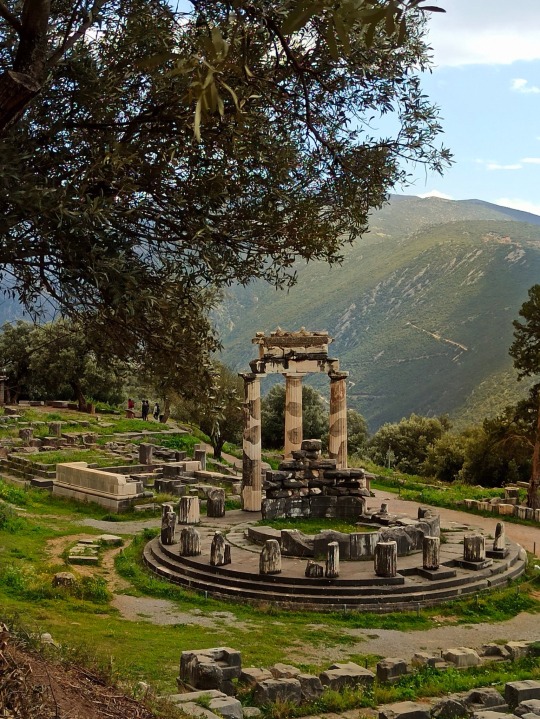
The Tholos of Delphi, Greece
#tholos of delphi#ancient greek#ancient greece#architecture#greece#delphi#greek#art#history#tholos#antiquity#classical#doric#columns#temple#temples#europe#european#photography#photograph#athena pronaia#phocis#ruins#archaelogy
3K notes
·
View notes
Text
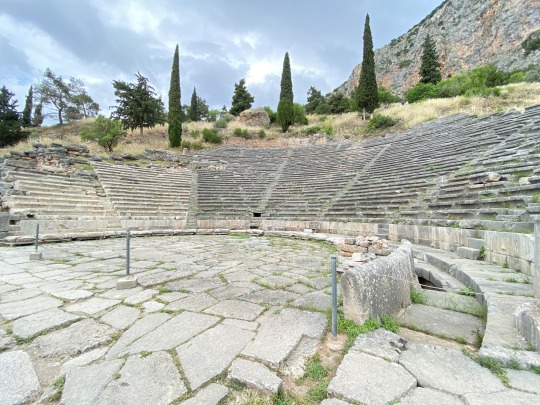
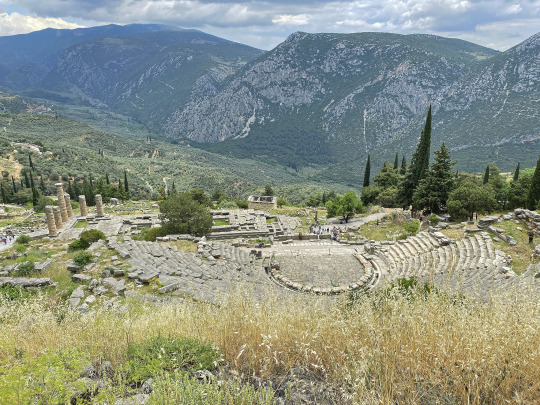
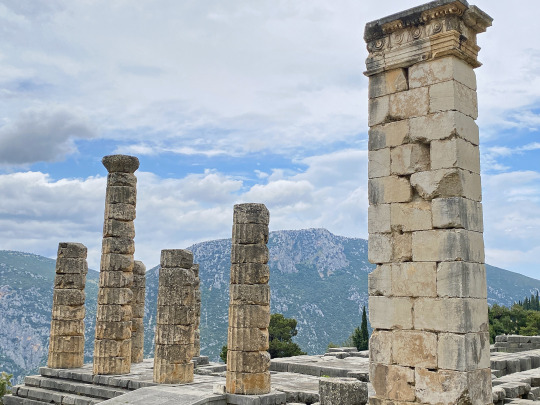

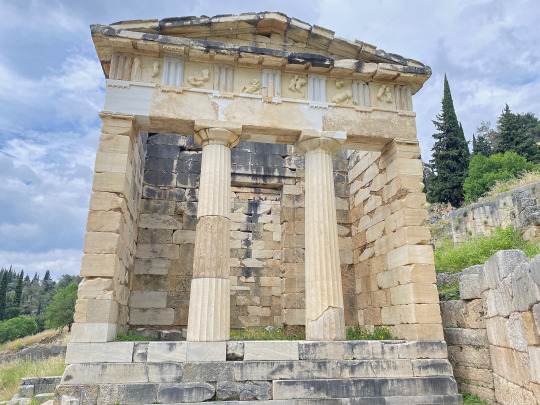
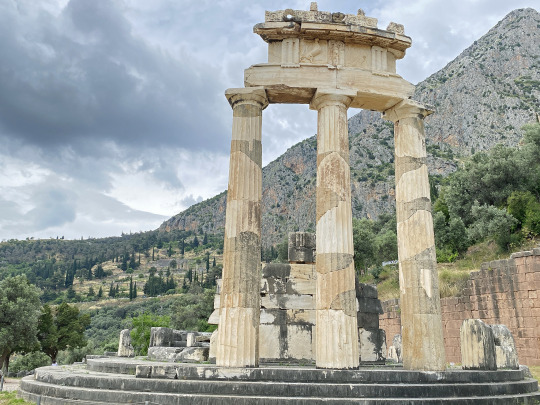
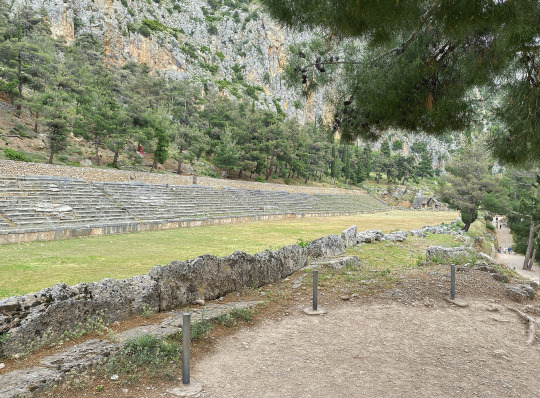
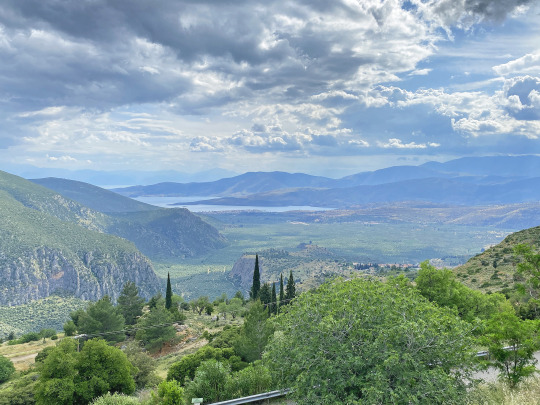
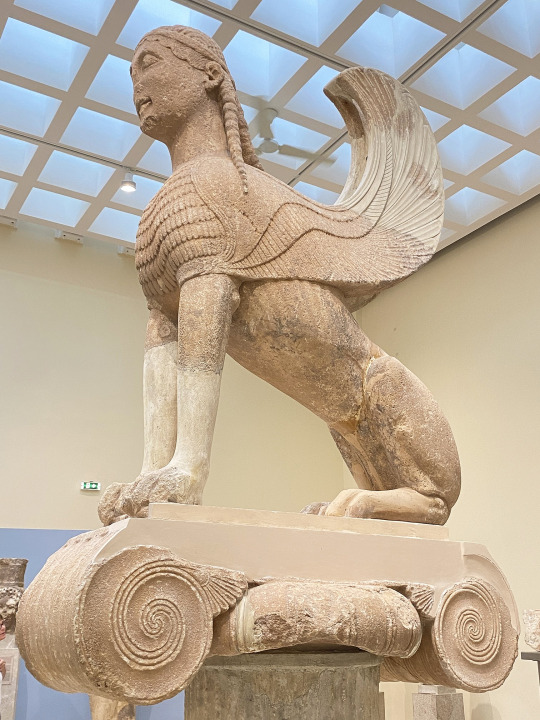

Delphi was such a beautiful place. Yes, the ruins were impressive, but the landscape and the ambient made it even better. So much green, big mountains everywhere and only birds singing (well, tourists too xD). I got so exhausted but it was totally worthy :D
#greece#delfos#delphi#ruins#archaeology#museum#mountains#gecko#sphinx#temple#tholos#apollo#athena#treasury#theater#stadium#sanctuary#ancient greece
170 notes
·
View notes
Text
A Pilgrimage to Delphi
Sketches in Athens: Poseidon Hadrian’s Arch Hadrian’s Arch Hadrian’s Arch Temple of Hephaestus Holy Buildings Jupiter’s Temple and Acropolis A column Mosque and Acropolis at Dusk And now Delphi: Temple of Apollo Tholos seen from above the Temple of Apollo The precipice at Delphi The Tholos The Temple of Jupiter seen through the Tholos A last view of the Tholos

View On WordPress
2 notes
·
View notes
Text
ask the Oracle of Delphi
In Delphi, where ancient tales unfold,A sanctuary of wisdom, revered and bold.The Oracle’s whispers dance with the breeze,Guiding seekers to answers they seek to appease.Amongst towering ruins and sacred springs,Delphi’s spirit forever sings. Tholos of Athena Pronaia A unique historical place in Greece Jump the Line and let us Guide you with our Private Tours

View On WordPress
1 note
·
View note
Text
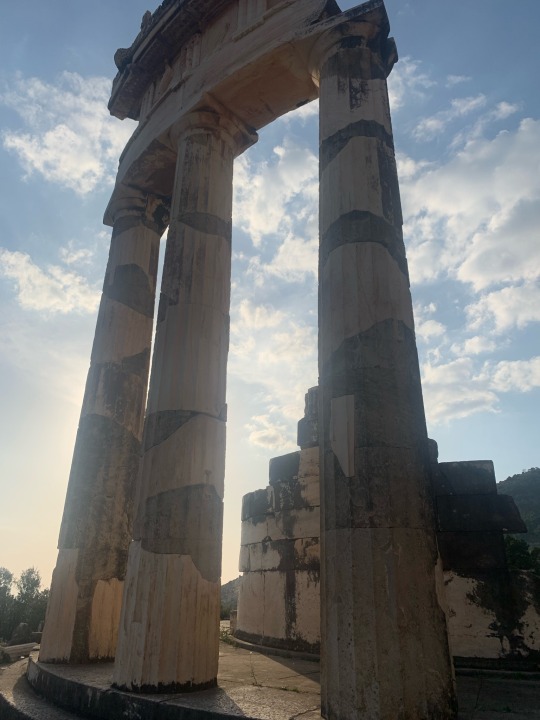

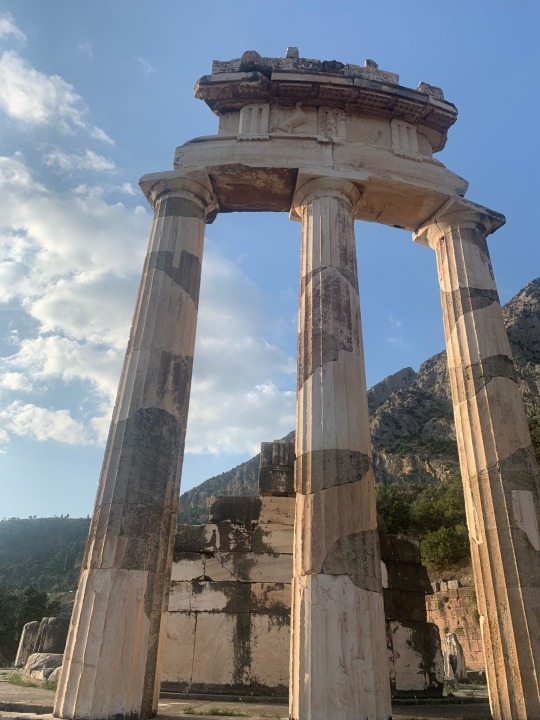
Tholos of Athena
Delphi, Greece
Photos by me, October 2022
#Delphi#tagamemnon#Greece#Ancient Greece#Athena#Hellenic Polytheism#Captain Kaltar’s Personal Log#I miss Greece So much and can’t wait to go back
171 notes
·
View notes
Text

Lady Athena and the little cat chilling on her tholos when I visited Delphi.

#athena#goddess of wisdom#goddess of war#greek mythology#myth#mythology#theoi#delphi#ruins#cat#kitty#pen and ink#illustration#art#drawing#artists on tumblr
405 notes
·
View notes
Text
oracle of delphi mentioned. heres a sneak peak of my lottienat oracle x misthia fic
It’s a chilly golden autumn morning when Lottie first touches Natalie’s skin. She’s standing out in the courtyard of the temple, under the branches of the old olive trees, the wind rustling around her with whispers. She has a cloak wrapped around her shoulders, but she isn’t cold. Her body shakes though, with an unknown anticipation— excitement for a union she has no idea is about to come.
She smells tobacco on the air. The first signal of their arrival. A scent like a memory, delivered to her on a silver plate to consume with vigor. She blinks and she’s somewhere else— a forest, it’s cold, colder than Lottie has ever felt even in the worst Grecian winter— but there’s a fire roaring, and someone sitting next to her, and there’s that smell again, tobacco and sweat and hunger— but it’s just a blink, and so in a moment Lottie is back under the olive tree, her shawl tangling around itself as she watches the leaves sway.
“Lottie?” There’s a voice calling out for her, familiar, though every voice is a little bit familiar these days. There’s hardly a face she hasn’t seen in a dream or a voice she hasn’t heard on the wind. But she knows this one— she’s heard it before, in this life and the next. It’s tenor is as strong as mountain soil.
Standing by the edge of the temple, beyond Lottie’s garden, Taissa arrives, as always, clad in leather, a sword on her belt. She arrives with the howl of a wolf and a burst of heat. She arrives with an uneasy hesitation— a distrust she has never, and will never, unlearn— and today, she arrives with a misthia whose footsteps Lottie has known since the moment of her first breath.
“Lottie?” Taissa calls out, again, like she’s apprehensive to come closer. Lottie isn’t reticent to receive her; she presses a palm to the olivewood and mumbles a quick blessing before turning to face the soldier and her company.
“Van said you were unoccupied,” Taissa starts, like it’s an apology, like her presence is unwanted. Her footsteps fall just short of the small clearing Lottie rests in, like it’s a sacred circle that she refuses to enter. “This is the misthia I told you about—”
“Natalie,” Lottie smiles. “I recall.”
Natalie is bound in leather straps and iron armor. Scale mail that accentuates the cording of her arms, white linens that flow around her knees in the brisk breeze, a leather cord across her brow that pushes her choppy dark hair away from her eyes— she is everything Lottie has seen in her dreams a thousand times over.
And she is here.
Natalie is behind Tai, but Lottie yearns to reach for her, to touch her hand, her cheek, to press her lips upon her lips, to strip her of her armor and lay her bare for all the Gods to bear witness to. Lottie almost lurches forward, overwhelmed with the breadth of her want, and as her foot catches in the dirt she watches as Natalie reaches forward as if to catch her, and then recoils.
Lottie does not fall. She regains her footing, stumbling heavily towards the invisible barrier that divides her visitors from her.
“Natalie,” Taissa says, ignorable to Lotties insatiable desire, to the meaning of this moment. She has no idea everything in history has led to this, that the Gods willed it from Olympus. “Of all the oracles I’ve met, Lottie is the most powerful. She’ll take care of you.”
Natalie looks to Lottie, looks at her with those fate-struck, storm cloud eyes, painted by Zues’ deft hand.
“I will,” Lottie’s dry mouth forms the words upon its own volition. “Let me take care of you, Natalie.”
They're sitting together in the tholos, the wall of stone circling them on all sides. Natalie looks claustrophobic in their shared privacy. Lottie revels in it.
“You’re good.” Natalie finally says, the first words she’s ever addressed Lottie with. “You’re really good.”
Lottie looks at her. “I haven’t done anything yet.”
“You know my name.” Natalie scowls. Her voice is so rich, so effortlessly deep, and it rattles in Lottie’s chest like a brass sistrum. “I told Tai not to tell you my name.”
Lottie inhales. She had been so caught up in the euphoria of seeing Natalie in the flesh that she had forgotten to act as if she never knew her. “Is it only possible that divination told it to me?” Lottie hums, amused. She isn’t sure why she’s playing coy. Maybe she doesn’t want to scare Natalie off. “Perhaps one of my priestess knew of you.”
Natalie shakes her head. “I don’t think that’s it.”
“Why?”
“When I saw you, I felt—” Natalie huffs. There’s trouble etched on her face. There always is, in Lottie’s dreams and visions. Natalie is the type of girl who trouble loves. “In my chest, there was—”
“You don’t have to explain.” Lottie finally grants the girl some relief. “It is no secret that I am touched by the gods. For many people, they are able to sense that strangeness about me. I’ve come to expect a certain level of hesitation when others approach.”
Natalie shakes her head. Her eyes are downcast, studying the stones beneath their feet. “Taissa was right about your massive ego.”
It’s unexpected, and so, so Natalie, that Lottie let out a rough burst of laughter. It’s a strange sound. She doesn’t make it often.
That gets Natalie to finally look up, to finally meet Lottie’s eyes.
“Tell me what troubles you, Natalie.”
“I have been asked by the Atticans to perform a sacred hunt.” Natalie begins. “A young girl, a worshipper of Artemis, was mauled by a bear that entered within the bounds of the city. They think the bear is an ill omen. A sign that they have fallen out of favor with Artemis. They hired me to pursue the bear so they can sacrifice it.”
“What do you think?”
Natalie side-eyes her. “Of what?”
“The hunt, the bear,” Lottie folds her hands in her lap, “It’s a great honor, to perform a sacred hunt. But you seem…” Hesitant is the first word that comes to Lottie’s mind, but it’s the wrong one. “Doubtful.”
Natalie tenses. She’s read her correctly. “It just doesn’t make sense to me, Lottie.” Her fists clench. “I heard the rumors. Spoke to the Atticans that were there when it happened. It was no random occurrence. They were keeping the bear, holding it hostage. They toyed with it like some— some house dog. Is it to blame for lashing out? Why should I punish it for doing what was in its nature?”
A distant smile crosses Lotties face. “How do you know Artemis did not will it so? Do you think the goddess of the hunt so shortsighted she could not foresee this one as well?”
Natalie snorts. “These days I doubt the gods see much at all.” She suddenly freezes, looking over at Lottie like a child caught thieving. “Sorry if that's like, sacreligious, or something.”
Lottie laughs again. She wants to reach for Natalie’s hand, but she knows the woman will just flinch away. “It’s alright. It’s not a terrible thought to have, when the workings of men are more often visible than the workings of the gods.”
“Not with you, though.” Natalie looks at her through hooded eyes. “You’re… different, Lottie.”
“Now who’s stroking my ego.”
Natalie chortles as that, and the sound of it, the familiarity of it, grabs Lottie by the shoulders and pushes her down—
(—and Lottie is spiraling into a dark tunnel, a dark abyss, and reemerging in a snow-covered forest where she’s surrounded by women. There's a fire roaring. There’s water running nearby. There’s leaves crunching, somewhere, off in the distance; and there’s Natalie’s laugh, low and honest, and suddenly Lottie feels like she’s underwater, floaty and freezing cold.
A hand brushes her palm. A hand covered in blood, a hand caked in dirt, a hand trembling and soft as its fingers reach for hers.)
“Lottie?” A voice is calling out to her. “Lottie, you with me?”
Lottie blinks, and she’s back in the tholos. She’s fallen to her knees, and her fingernails are broken and dusty, the skin scraped raw. She’s been digging at the stone floor. Digging.
The voice says, “It’s okay, Lottie,” and it grounds her, pulls her back to the present, away from the smell of blood and bonfire and back to salt and sweet rosemary. She’s here. She’s in the tholos. She’s with Natalie. “It’s okay.”
Natalie is on her knees before her, eyes staring down Lottie, like she’s waiting for her to jump, or bite, or run. She looks scared.
Lottie wants to kiss her.
She doesn’t. She pushes herself up with shaky legs, Natalie’s hand hovering by her elbow to catch her if she falls.
“Apollo is on the wind today,” she mutters to herself. Then— louder, more confident, to Natalie— “Follow me to the temple. I’m going to bless your hunt.”
Natalie, kneeling beneath the altar of Apollo. Natalie, head bowed in concentration. Natalie, with the curious eyes of a hunter, following Lottie as she moves gracefully about the temple, preparing her prayer.
In all her dreams, there has always been something about Natalie that seemed impossible to Lottie; like the feeling one gets before a thunderclap or strike of lightning, like the uncontrollable wrath of something quite divine and uncaring. Natalie buzzes with power— with rage. It’s enough to make Lottie take her time as she gathers her cups, her wine, her dagger. She’s worried once she approaches Natalie, the storm that surrounds her will strike out and smite Lottie to dust.
“You’ve always had this… power about you,” Lottie says, if only to put her thoughts to words so they can reside anywhere but her chest, the inside of her mouth, and she can keep doing her fucking job.
“What the hell does that mean?” Nat snaps, only a little bit cruel. She’s mostly just cautious, of course— she hasn’t seen what Lottie has seen, doesn't know what Lottie knows.
Lottie stalks a little bit closer. The loose folds of her dress swirl about her ankles.
“It means you’re special, Natalie.”
And Natalie looks away. “Tai was right. You’re fucking strange.”
Lottie shrugs, lets the words bounce off her chest. She diverts, in the hopes to get Natalie to open up to her a little. “How do you two know each other?”
“You don’t know?” It’s Lottie’s turn to shrug. “We fought together. Persians, then the Spartans.” Nat works at a scar near her temple, like the discomfort is still there long after the wound’s healing. “Now Tai commands an Athenian phalanx and I am…here.”
“Here is not a bad place to be,” Lottie says, finally depositing all of her instruments behind Natalie upon the altar. “The people of Attica are grateful you are here.”
“What about you?” Natalie snarks. ”Are you grateful I am here? Got nothing better to do than grant a washed-up mercenary paltry blessings?”
Lottie dips her fingertips in the ash of the brazier beside the altar, then takes Nat’s chin gently in her other hand.
“I have waited my entire life for this moment,” Lottie says. “There is no other place I would wish you be.”
Natalie’s plump red lips part— her eyes grow glassy, like the seawater on a still summer day. Lottie brings her thumb up so it rests, trembling, on the outline of the luxurious skin, bending pliant beneath the soft tug of Lottie’s finger.
Natalie looks so good for her like this. On her knees, obedient. Reverent.
Lottie takes her other hand, the one dappled with ash, and brushes away the soft strands of Nat’s fringe to allow access to the skin of her brow. She traces a symbol into the skin there, the one she’s seen in her dreams a thousand times over.
(O, shining Apollo, watch over Natalie and embrace her in your warmth, keep her in your sight; golden-haired father, I am your servant always in your light and worship but Natalie is my love, my beating heart; show her way as only you can, guide her hand to fruition, bring her back safe to me—)
On the final stroke, Lottie’s hand recoils— Natalie’s skin has grown searing hot, and it burns at her fingertips as she finishes the seal on the sigil she’s carved with ash. She hisses as she pulls her hand back, examining her fingertips carefully.
“You okay?” Nat asks, looking altogether like a tantalising sacrifice sporting Lottie’s mark on her forehead.
“Did you feel that?” Lottie whispers. “That— that heat?”
Nat flushes pink. Her pupils dance in the flickering firelight that surrounds them. “Yeah, maybe,” she huffs.
“That’s not what I—” Lottie scowls. “—regardless. You can stand, now.” When Natalie doesn’t move, looks at her skeptically, Lottie tacks on a: “Please.”
Nat grunts, pushing herself to her feet, the plates and rivulets of her armor jingling like strings of glass beads in the wind. It's a sound that soothes Lottie subconsciously, a sound she is paradoxically both unfamiliar with and yet fond of.
While Nat gets her bearings, Lottie circles around the altar, plucking her things as she goes— a copper cup that Mari prepared for this ritual, embalmed with flaky gold, a carafe of dry wine that she mixes with water from a local lake, that Van always claims nymphs can be found whispering in. She drops in a couple of sun-blanched herbs from her garden, then picks up her knife and goes to stand beside Natalie.
“The blessing and the sigil will only serve to invite the gods' protection over you. Think of it as a signal fire at night— I have marked you in such a way that the gods upon Olympus high cannot ignore.” Not that they were ignorant to you before. “If you truly wish to succeed in this hunt, I will invite Apollo’s sight to flow within you, so that you may anticipate your prey’s every move.”
“It’s a little much for a bear hunt, Lottie.”
Lottie smiles, placating. “A sacrifice to Artemis should only be fetched by one so blessed as she. The maiden would have it no other way.”
“Oh,” Natalie breathes out, looking up at Lottie with those full-moon eyes. “Well, bless away, then.”
Lottie answers by sliding the blade of her dagger across her palm.
Immediately, the images flood to the front of her mind; Natalie in the forest, running for her life— Lottie, at the altar, begging for it— Lottie’s hand in Natalie’s, bloodied and bruised.
She sees Natalie’s hand twitch— instinctual, the need to curb violence, to control it— but then Lottie lets out a groan that comes from some deep, curling snake in her gut, and Natalie freezes.
“Lot—” She whispers, but Lottie holds up a hand to silence her.
“I’m fine.” Lottie lets the knife fall to the floor. She takes her slashed palm and works it with her fingers, bringing all her blood to the surface, cupping it so it will not spill or waste a drop. She grabs the copper cup from her dias and turns her palm over, letting the blood pour out in a sloppy stream into the water and wine.
Lottie gives it a gentle stir. Watches the way the rivulets of red dissolve into an even pink that reminds her of a violent sunset.
“Drink this,” Lottie says, offering the cup to Natalie, “and let the blood of the Oracle grant you clear sight on your hunt.”
Natalie looks at the proffered elixir. A storm of thoughts races through her mind; none that Lottie understands. Maybe, after everything, this is the step too far— this is where Natalie draws the line and leaves Lottie in the shadow of her god, begging for something she can never have. In another life, it would be true; in her dreams, it always ends before the good part.
But in the temple, on this day, Natalie takes the cup from Lottie’s trembling hand, and she brings it to her lips, and she drinks, and she drinks, and she drinks.
#yellowjackets#yellowjackets fic#lottienat#lottie matthews#natalie scatorccio#apollo on the wind#mike writes#this fic is almost done i just have to finish the smut :)
5 notes
·
View notes
Text

Hey so I made an Alternative Advent Calendar in 2021 with Ancient Greek Mythical Creatures in it. I made some physical copies and then a PDF to download-and-print at home because postage/time.

She got one 😁

I’m making another one this year with Ancient Greek Mythical Women, so I’ve made a fantasy temple version based on the Tholos of Athene outside Delphi and the Tholos temple of Vesta in the House of the Vestals, Rome. I’ve literally be thinking about it for an entire year 😂

Here’s a sly peek at it (uncut).
Is it pretty? I really want it to be pretty.
The old one download-and-print: https://greekmythcomixshop.wordpress.com/2021/11/06/new-ancient-greek-mythological-creatures-advent-calendar/
Also one that you can print blank for classes to colour in: https://greekmythcomixshop.wordpress.com/2021/11/10/new-ancient-greek-colour-in-draw-your-own-mythological-creatures-advent-calendar-teachers-edition/
#alternative advent calendar#ancient Greek advent calendar#greek mythology#tagamemnon#greek myth#illustration#greek myth comix#comix#Ancient Greek mythical women#ancient greek mythology#advent calendar#download and print#teaching resources#classical civilisation#mythical creatures
20 notes
·
View notes
Text

tholos treasury of the temenos of athena pronaia at delphi
14 notes
·
View notes
Text
Unveiling the Wonders of Ancient Greece: An Epic Culture Tour in 2024
Exploring the Rich History of Ancient Greece
In 2024, embarking on an epic cultural tour of Ancient Greece offers an unparalleled journey through time, immersing visitors in the cradle of Western civilization. The remnants of this illustrious civilization stand as testaments to its influential history, intellectual advancements, and architectural marvels. This guide will navigate you through the essential landmarks, cultural experiences, and hidden gems of Ancient Greece, ensuring a profound and memorable adventure.
The Acropolis of Athens: A Timeless Beacon
The Acropolis of Athens is an unmissable highlight on any tour of Ancient Greece. Perched high above the city, this ancient citadel boasts some of the most significant structures of classical antiquity. The Parthenon, dedicated to the goddess Athena, dominates the Acropolis and exemplifies the zenith of Greek architectural achievement. Visitors can also explore the Erechtheion, known for its distinctive Caryatids, and the Temple of Athena Nike, symbolizing victory.

Delphi: The Oracle’s Enigmatic Legacy
Delphi, revered as the center of the world in ancient Greek religion, was home to the famous Oracle of Apollo. Nestled on the slopes of Mount Parnassus, the Sanctuary of Apollo invites travelers to wander among its ruins, including the Temple of Apollo, where the oracle delivered her prophecies. The adjacent Theater of Delphi and the well-preserved Stadium highlight the importance of cultural and athletic competitions in Greek society.

Olympia: The Birthplace of the Olympic Games
The ancient site of Olympia is synonymous with the Olympic Games, which began here in 776 BCE. The Temple of Zeus, once housing one of the Seven Wonders of the Ancient World — the colossal statue of Zeus — remains a focal point. The extensive ruins also feature the Temple of Hera, the ancient stadium, and the Philippeion, an elegant circular memorial.

Mycenae and Epidaurus: Myths and Healing Sanctuaries
In the Peloponnesian Peninsula, Mycenae and Epidaurus offer contrasting yet equally captivating experiences. Mycenae, the legendary home of King Agamemnon, features the impressive Lion Gate and the Treasury of Atreus, a monumental tholos tomb. In contrast, Epidaurus is celebrated for its ancient Theater, renowned for its exceptional acoustics, and the Sanctuary of Asclepius, the god of medicine, reflecting the advanced medical practices of the time.

The Mystical Island of Delos
A short boat ride from Mykonos, the island of Delos holds significant mythological and archaeological importance. Believed to be the birthplace of Apollo and Artemis, Delos flourished as a major religious and commercial center. Visitors can explore the Sanctuary of Apollo, the Terrace of the Lions, and the well-preserved House of Dionysus with its intricate mosaics.

Knossos: The Minoan Marvel
The ancient city of Knossos on Crete, associated with the legendary King Minos and the Minotaur, is a must-visit for those intrigued by Minoan civilization. The Palace of Knossos, with its complex layout and vibrant frescoes, provides insights into the advanced society that thrived here around 2000 BCE. The Hall of the Double Axes and the Throne Room are particularly noteworthy.
Nafplio: The Gateway to the Peloponnese
Nafplio, a charming coastal town, serves as an excellent base for exploring the Peloponnese. Its Palamidi Fortress offers panoramic views of the surrounding area, while the Bourtzi Castle on a small island in the harbor adds to its picturesque allure. Strolling through Nafplio’s narrow streets, lined with neoclassical mansions and vibrant bougainvillea, is a delightful experience.
Cultural Immersion and Modern Experiences
Beyond the ancient ruins, immersing oneself in modern Greek culture is equally rewarding. The vibrant neighborhoods of Plaka and Monastiraki in Athens brim with traditional tavernas, bustling markets, and artisan shops. Savoring authentic Greek cuisine, from succulent souvlaki to fresh seafood, enhances the cultural journey.
The National Archaeological Museum of Athens
A visit to the National Archaeological Museum of Athens provides a comprehensive understanding of Greece’s rich history. Housing an extensive collection of artifacts, including the Mask of Agamemnon, the Antenor Kore, and the Antikythera Mechanism, the museum offers invaluable context to the sites explored.
Greek Festivals and Celebrations
Participating in local festivals such as the Panathenaic Festival in Athens or the Apokries (Greek Carnival) adds a dynamic layer to the cultural experience. These celebrations, steeped in tradition and community spirit, showcase the enduring legacy of ancient customs in contemporary Greek life.
Conclusion
Embarking on a cultural tour of Ancient Greece in 2024 promises a profound exploration of humanity’s shared heritage. From the architectural splendor of the Acropolis to the mystical ambiance of Delphi, the enduring legacy of this ancient civilization continues to inspire and educate. By delving into the historical sites, partaking in cultural practices, and immersing in the vibrant modern Greek lifestyle, travelers gain a comprehensive appreciation of Greece’s monumental contributions to the world.
Website | Facebook | Instagram | Tumblr| BlogSpot | Medium
0 notes
Text

Greek design extends from c. 900 B.C.E. to the first century C.E. (with the earliest surviving stone engineering dating to the seventh century B.C.E.). Ancient Greek draftsmen took a stab at the accuracy and greatness of workmanship that are the signs of Greek craftsmanship overall. The equations they imagined as right on time as the 6th century B.C. have impacted the design of the previous two centuries. The two chief orders in Archaic and Classical Greek design are the Doric and the Ionic.
The way into the evergreen allure of the design style is in its ‘logic and order’, which radiates amiability and excellence in the structures. The point was to accomplish and depict the Greek Principle of ‘Arete’, which signifies ‘accomplishing one’s finished potential.
1. Greek Architecture was influenced by various cultures

Image: https://diplomaofbuildingandconstruction.blogspot.com/2022/05/construction-and-architects-faq.html
2. Oriental societies influenced the Greek settlements along the shore of Asia Minor (Turkey)
The beginnings of Greek compositional plan are not to be found in the different strands of Aegean workmanship that showed up in the eastern Mediterranean, strikingly Minoan or Mycenaean craftsmanship, yet in the Oriental societies that emptied their persuasions into the Greek settlements along the shore of Asia Minor (Turkey) and from that point to Hellas itself. Since the time of the Geometric Period (900–725 BCE), the principal undertaking of the Greek draftsman was to plan sanctuaries respecting at least one Greek divinities. Truth be told until the fifth century BCE it was his lone concern. The sanctuary was only a house (Oikos) for the god, who was addressed there by his clique sculpture, and most Geometric-period establishments show that they were developed by a straightforward square shape. As indicated by fired models (like the eighth-century model found in the Sanctuary of Hera close to Argos), they were made out of rubble and mud blocks with wood radiates and a covered or level earth rooftop. By 700 BCE, the last was superseded by a slanting rooftop produced using terminated mud rooftop tiles. Their insides utilized a standard arrangement adjusted from the Mycenean castle megaron. The sanctuary’s principal room, which contained the sculpture of the god, or divine beings, to whom the structure was devoted, was known as the cella or naos.
Generally, Greek Architecture is associated with Temple-Architecture or Other Public Buildings
Greek city-states put significant assets in sanctuary working — as they rivalled each other in key and financial terms, yet in addition in their engineering. For instance, Athens committed colossal assets to the development of the Acropolis in the fifth century B.C.E. — to a limited extent so Athenians could be sure that the sanctuaries worked to respect their divine beings outperformed anything that their opponent states could offer.
Ancient Greek sanctuaries highlighted relatively proportional design, sections, friezes, and pediments generally adorned with sculpture in help. These components give old Greek Architecture its unmistakable person. The ancient Greek planners fabricated sanctuaries to be seen from an external perspective. Individuals were by and large not permitted inside them.
Layout development in Ancient Greek Architecture
The Old Greek underlying style that energetically influenced later architecture is the colonnade. A Colonnade is a line of sections supporting an entablature. It will in general be joined to a design (as in a porch) or detached. Sanctuaries with a peripheral plan (from the Greek πτερον (pteron) meaning “wing”) have a single line of sections organized all around the outside of the building. Dipteral sanctuaries simply have a twofold line of sections including the design. One of the additional astonishing plans is the tholos, a sanctuary with an indirect ground plan; well-known models are confirmed at the place of refuge of Apollo in Delphi and the place of refuge of Asclepius at Epidauros. The configuration of the internal heavenly spot, various burdens (expecting to be any), and including segments, generally, followed one of five fundamental plans, named as follows.
If the entry to the cella combined two or three areas, the construction was known as a “templum in antis”. [“in antis” means “between the divider pillars”] (Example: Siphnian Treasury, Delphi, 525 BCE; or Temple of Hera, Olympia, 590 BCE.)
If the path was gone before by a porch of areas across its front, the construction was known as a prostyle asylum. (Model: Temple B, Selinunte, Sicily, c.600–550 BCE.)
Assuming the patio of areas at the front, there was a passage of fragments at the back outside of the cella, the design was known as an amphiprostyle safe-haven. (Model: Temple of Athena Nike, Athens, 425 BCE. Then again see the later Temple of Venus and Roma, Rome, 141 CE.).
If the passage enveloped the entire design, it was known as a fringe asylum. (Model: The Parthenon, Athens, 447–437 BCE).
If the passageway including the construction contained a twofold line of sections, it was known as a dipteral asylum. (Model: The Heraion of Samos, 550 BCE; or Temple of Apollo, Didyma, Asia Minor, 313 BCE.)
Use of Geometry in Greek Architecture
It is most plausible that the antiquated Greek architects proportioned their sanctuary plans by utilizing straightforward mathematical developments to decide the essential generally speaking extent of the structure. (Leonardis, 2016). The main mathematical strategy is multiplying the space of a square, an extremely antiquated technique discovered currently in Babylonian earth tablets (Wilson Jones 2000b: 90–93).
The headway of sensible and speculative math by the old Greeks was an immense social accomplishment, and it showed the essentials for the advancement of the Greek plan. The second basic numerical technique is a relative extent, which moreover has common sense work. The plan cycle was probably refined by drawing traces. These graphs were, in light of everything, comparing and supporting the affirmation of areas.
The modellers of old-style Greece considered numerous cutting-edge strategies to make their constructions look totally even. They made symmetrical planes with an outstandingly slight vertical U-shape and areas that were fatter in the middle than at the terminations. Without these progressions, the designs would appear to list; with them, they looked perfect and radiant.
Deriving a Formula and its Order of Architecture
The change from block and wood to more lasting stone invigorated Greek modellers to plan an essential compositional “format” for sanctuaries and other comparable public structures. This first “format”, known as the “Doric Order” of engineering, set out a progression of rules concerning the qualities and measurements of sections, upper veneers, and enhancing works. The resulting “layouts” incorporated the Ionic Order (from 600) and the Corinthian Order (from 450).
Ancient Greek design concocted three principles, “orders” or “layouts”: the Doric Order, the Ionic Order, and the Corinthian Order. These Orders set out a wide arrangement of rules concerning the plan and development of sanctuaries and comparative structures. These guidelines directed the shape, subtleties, extents, and corresponding connections of the sections, capitals, entablature, pediments, and stylobate.
Development of Stone Architecture
From the get-go in Greek history, sanctuaries were made of wood. Stone, particularly marble, turned into the material of decision in the seventh century BC. Marble was exceptionally abundant in Greece.
Until about 650 BCE, mid-way through the Orientalizing Period (725–600 BCE), no sanctuaries were built in complete stone. Be that as it may, from 650 BCE onwards, or somewhere around there, there was a recharging of contacts and exchange joins among Greece and the Middle East, including Egypt, the home of stone engineering. (See: Ancient Egyptian Architecture.) Subsequently, Greek originators and bricklayers got comfortable with Egypt’s stone structures and development methods, including those of Imhotep, which prepared for fantastic engineering and models in Greece. This cycle — known as “petrification” — included the supplanting of wooden designs with stone ones. Limestone was normally utilized for columns and dividers, while earthenware was utilized for rooftop tiles and marble for ornamentation. It was a progressive cycle, which started in the last piece of the seventh century, and a few designs, similar to the sanctuary at Thermum, consisted of wood and terminated mud, just as stone.
The Structure Development of Stone in Greek Architecture
The mystery that keeps the architecture standing pleased, without the smallest harm from the seismic tremors that have occurred over a load of years, effectively goes against the hypothesis of present-day structural designing because without having an establishment, it is triple seismically protected. This triple protection is situated in various pieces of the structure. The principal point is situated on the layers of enormous flat and amazingly smooth marble on which the Parthenon steps. The second is seen in the metal versatile joints which associate the plates of each layer and in the focal point of which are found little iron heaps around which lead has been poured. Also, the third is situated in the segments of the structure, which were not put in one piece, since the antiquated Greeks realized that to withstand the vibrations of the earth, they must be set in cuts of marble, consummately applied to one another. The segments — at long last — in the manner they were set, permitted the entire structure to sway however not break!
Colors were striking and bold to emphasize the buildings in Greek Architecture
Every one of the information that students of history and archaeologists have available to them shows that the Parthenon didn’t have the white shading we see today. All things considered, it was painted in numerous splendid tones! Until the start of the nineteenth century, the deliberate uncovering of old Greek locales had brought to the front plenty of models, some of which had noticeable hints of brilliant surfaces. Utilizing focused energy lights, bright light, and exceptionally planned cameras, it is demonstrated that the entirety of the Parthenon Images was painted.
The Greeks consistently painted their marble sanctuaries. They appear to be not exclusively to have painted them, however, to have utilized pretentious tones for the reason, revealing liberally in red, blue, and gold. There probably has been some endeavour to associate tone and construction, with the primary individuals kept clear and remarkable, the lower parts minimal hued, and the upper parts alone blooming in tone as they did in sculptural embellishment, however, all proof has since a long time ago disappeared.
Legacy Of Greek Architecture
The Romans were huge manufacturers, designers, and draftsmen by their own doing, however throughout vanquishing the Western world, they were exceptionally impacted by Greek aesthetics. The enormous utilization of the Ionic, Doric, and Corinthian Orders is the clearest model. One common kind of building was a basilica, which was created from the Greek Stoa, yet was completely encased instead of enclosed on one side. The lobby contained corridors within, which assisted with getting sorted out and partitioning the inside space.
#carpentry courses in melbourne for domestic students#carpentry courses in melbourne for international students#painting and decorating course melbourne#carpentry courses melbourne for international students#Beginner to Advanced Level English Courses in Melbourne#certificate iii in cabinet making melbourne#certificate 3 in cabinet making melbourne#carpentry course melbourne#cabinet maker course melbourne#Certificate III in Cabinet Making and Timber Technology#diploma of leadership and management melbourne for international students#Advanced Level English Courses in Melbourne#General English Program Melbourne#General English Courses Melbourne#Beginner English Courses in Melbourne
0 notes
Text
Unveiling Ancient Wonders: A Private Tour of Delphi and Thermopylae from Athens

Unforgettable Journey through Time
Embark on a captivating adventure as we take you on a private tour from Athens to the enchanting realms of Delphi and Thermopylae. Delve into the heart of ancient Greece, where myth and history intertwine, and let the stories of gods, heroes, and battles come to life.
A Glimpse into Delphi's Mystique
The Oracle's Sanctuary
Our journey begins with a visit to the mystical Delphi, the sanctuary of Apollo and home to the famed Oracle. Walk in the footsteps of ancient pilgrims as you explore the sacred grounds, surrounded by the breathtaking landscape of Mount Parnassus. Feel the energy of the Temple of Apollo and stand in awe at the grandeur of the ancient theater that once echoed with the voices of spectators.
The Omphalos - Center of the World
Discover the significance of the Omphalos, the legendary navel of the world. Uncover the secrets of the Delphic Oracle, who, through cryptic prophecies, influenced the destinies of kings and heroes. Marvel at the intricate architecture of the Tholos of Delphi and ponder the mysteries that still linger in the air.
Echoes of Heroism at Thermopylae
The Battlefield of the 300
Step back in time to one of the most iconic battlefields in history – Thermopylae. Hear the echoes of Leonidas and the brave 300 Spartans who faced the Persian army. As you stand at the Hot Gates, let the tales of valor and sacrifice resonate in the very air that witnessed this epic clash.
Monument of Leonidas
Visit the Monument of Leonidas, a tribute to the Spartan king who led his warriors against overwhelming odds. Gain insights into the strategies and tactics employed during the Battle of Thermopylae, and appreciate the enduring legacy of these heroic defenders.
Seamless Private Tour Experience
Our private tour ensures a personalized and immersive experience. A knowledgeable guide will lead you through these ancient wonders, providing historical context and engaging stories that bring the sites to life. Enjoy the flexibility to explore at your own pace, allowing time for reflection and capturing the beauty of these remarkable landscapes.
Booking Your Journey
Join us on this extraordinary adventure through the pages of ancient history. Book your private tour of Delphi and Thermopylae from Athens and unlock the secrets of Greece's rich past. Immerse yourself in the tales of gods, heroes, and epic battles that have shaped the course of civilization.
1 note
·
View note
Text
Welterbe (auf)gespürt und (er)fahren – GR – Archäologische Stätte von Delphi
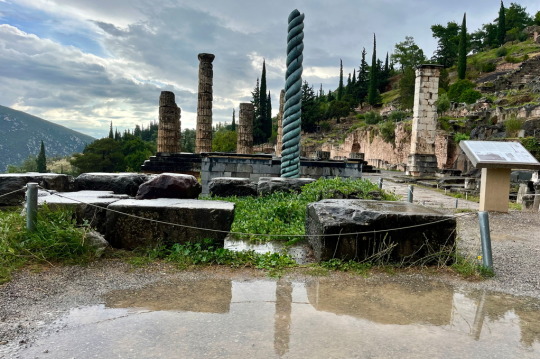
Auf der Fahrt nach Delphi folgt mir der Regen auf dem Fuße und ich hoffe, dass ich mir noch einiges trocken anschauen kann. Als ich die 10 km lange Abfahrt nach Delphi nehme, ist der Blick atemberaubend. Leider gibt es keinen Platz für einen Fotostopp. Trotz der Nachsaison ist auch die Straße am Heiligtum fast zugeparkt, ich finde mit etwas Glück noch einen der letzten Plätze. Das Heiligtum von Delphi liegt zwischen zwei hohen und steilen Felsen des Berges Parnassus, die auch als die leuchtenden Felsen (Phaidriades) bezeichnet werden. Das Gebiet war von etwa 1.500-1.100 v. Chr. von den Mykenern besiedelt. In den Augen der alten Griechen war Delphi das Zentrum der Welt (Omphalos), denn dem Mythos nach trafen sich hier zwei von Zeus freigelassene Adler. Im 8. Jahrhundert v. Chr. wurde das Heiligtum errichtet, das Apollo, dem olympischen Gott des Lichts, des Wissens und der Harmonie, gewidmet war. Im 6. Jahrhundert v. Chr. nahm sein religiöser und politischer Einfluss zu und Delphi wurde das religiöse Zentrum und Symbol der Einheit der antiken griechischen Welt. Sein Ruhm und Ansehen verbreiteten sich und zogen Pilger aus aller Welt an, die ein Orakel von Pythia, der Priesterin des Apollon, empfangen wollten. Der prächtige Monumentalkomplex aus Tempeln, Terassen und Schatzkammern befindet sich in perfekter Harmonie mit seiner natürlichen Umgebung. Dies ist bis heute unverändert so und Delphis Erbe, das die antiken Griechen der Nachwelt hinterlassen haben, steht seit 1987 auf der UNESCO-Welterbeliste.

Von meiner Parkbucht sehe ich die Tempelanlage steil am Berg vor mir liegen. Ich hoffe, dass der Himmel aufreißen wird, um sie golden scheinen zu lassen. Doch zunächst folge ich einigen Besuchern, die den Weg gegenüber ins Tal nehmen und komme, vorbei am alten Gymnasium, zum Tempel der Athene. Daneben steht der beeindruckend schöne Tholos von Delphi. Dieser Teil der Stätte ist übrigens frei zugänglich.


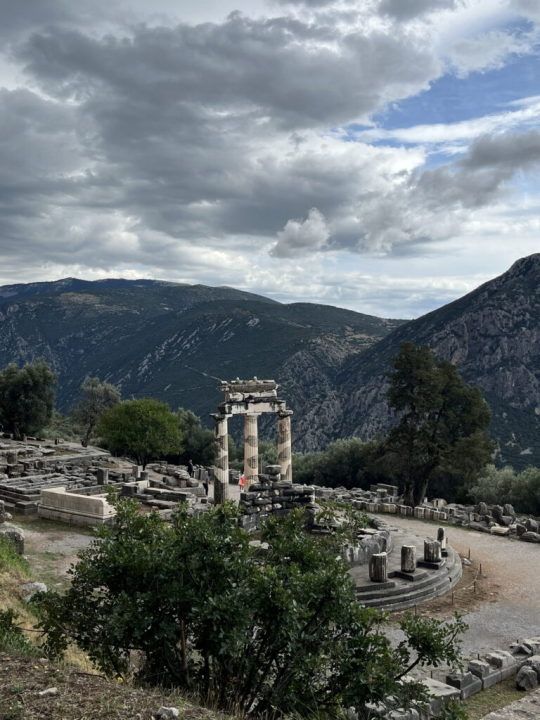

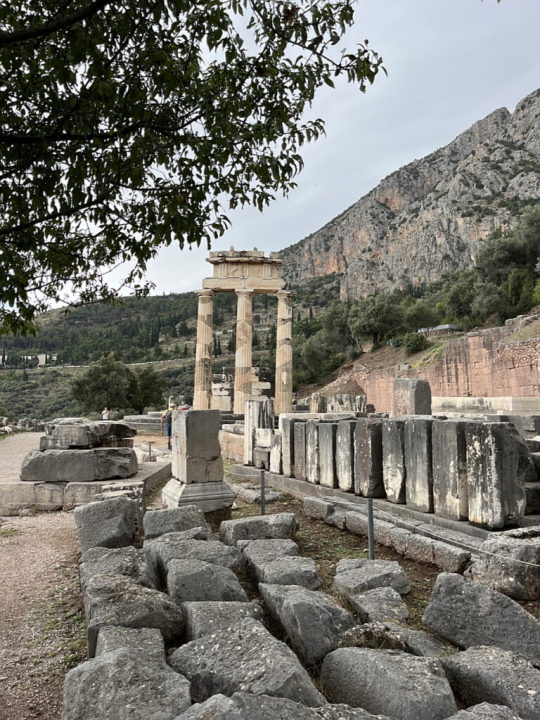
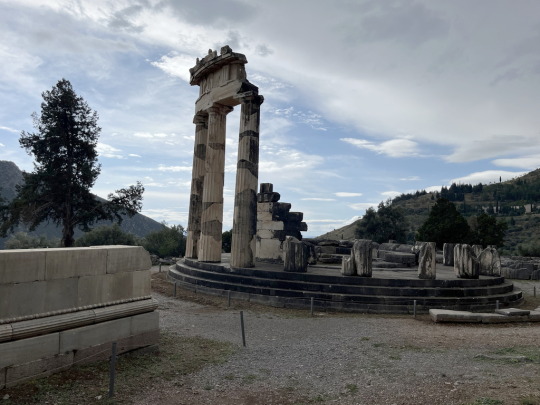
Bevor ich den Apollon-Tempel besuchen kann, überrascht mich ein heftiges Gewitter.

Ich warte bei einer Tasse Tee im Auto ab und schließe mich dann einer Reisegruppe an, die mit ihren bunten Schirmen fröhliche bunte Farbtupfer vor den dunklen Himmel setzt.
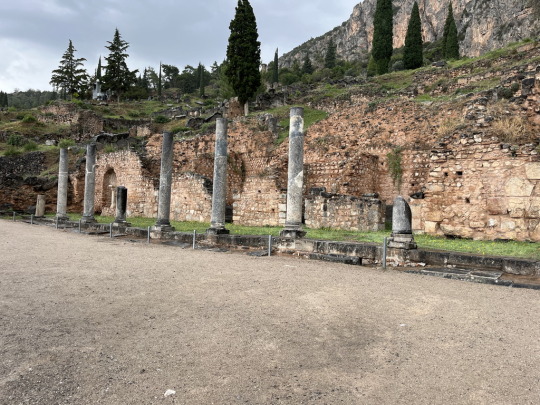

Der Rundgang beginnt an einer römischen Einkaufsstraße mit kleinen Läden entlang der Mauer und einem Säulengang davor. Ich stelle fest, dass sich seitdem gar nicht so viel geändert hat. Danach geht es steil den Berg hinauf und wir kommen wir zum Tempel des Orakels, dem wohl bekanntesten Anziehungspunkt von Delphi.
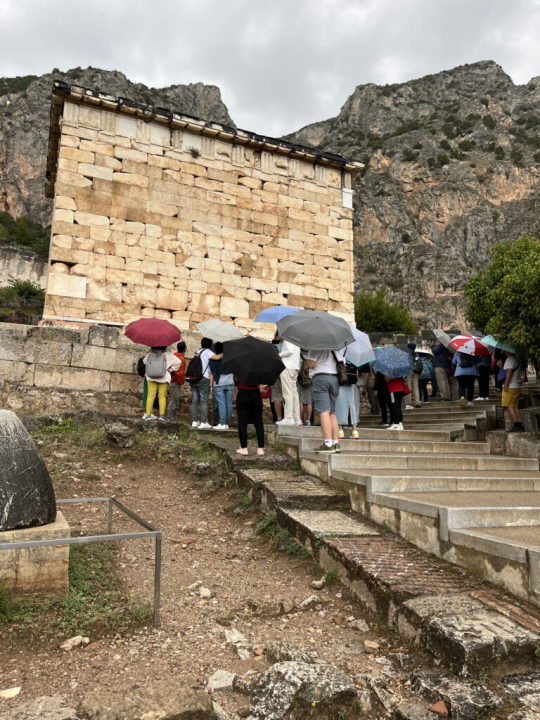
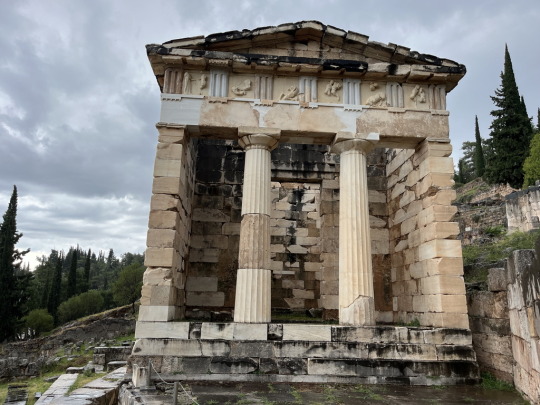
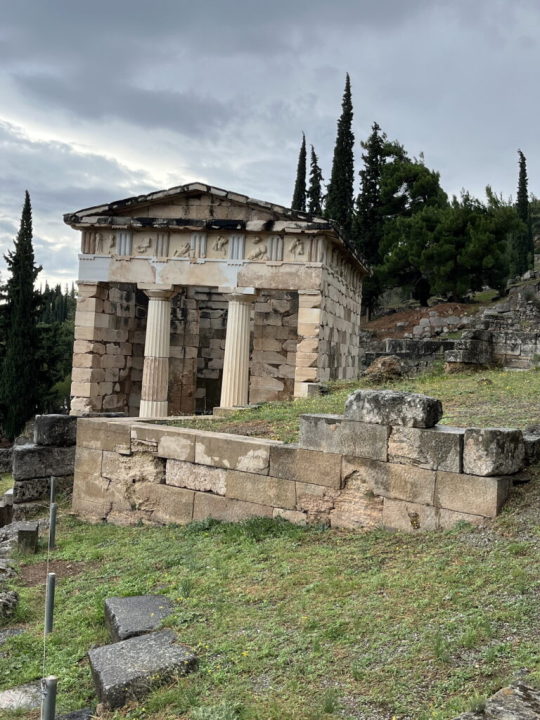
Es geht immer weiter steil nach oben zum Tempel des Apollo, der hier erhaben mit einem Wahnsinnsblick hinunter ins Tal thront.


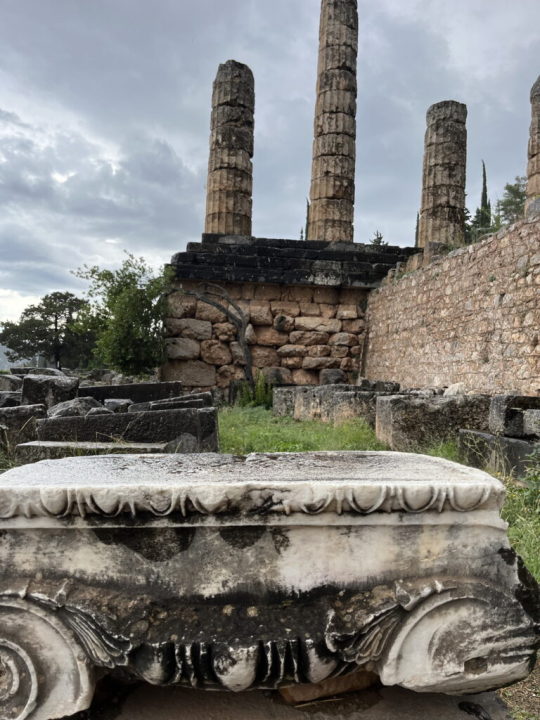
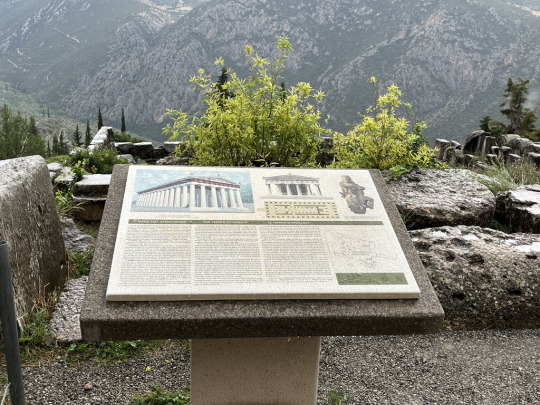
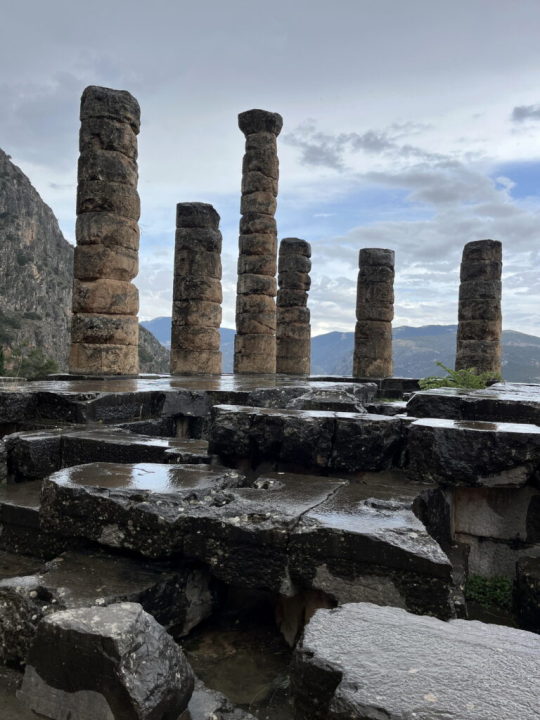
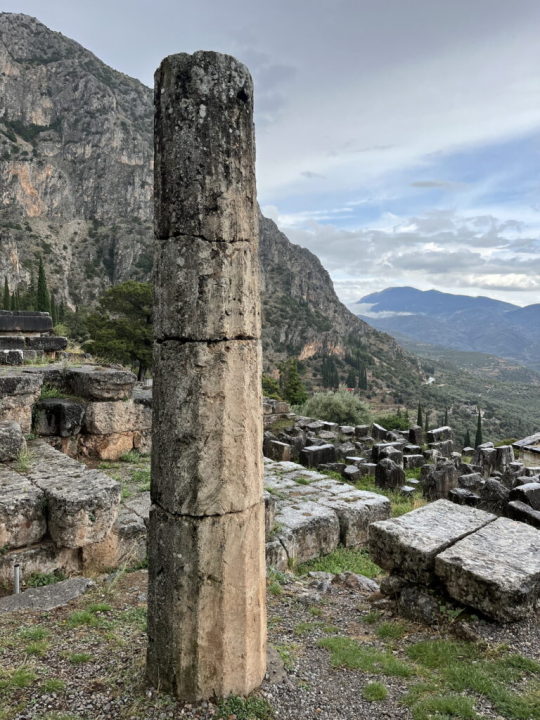
Das benachbarte Stadion wird gerade rekonstruiert, so dass wir es nicht betreten können. Doch daneben stehen einige bemerkenswerte Säulen bzw. ihre Kopien. Sie spiegeln sich in den Pfützen des gerade vergangenen Wolkenbruchs. Ursprünglich waren sie mit Figuren geschmückt, die ich später im Museum sehen kann.
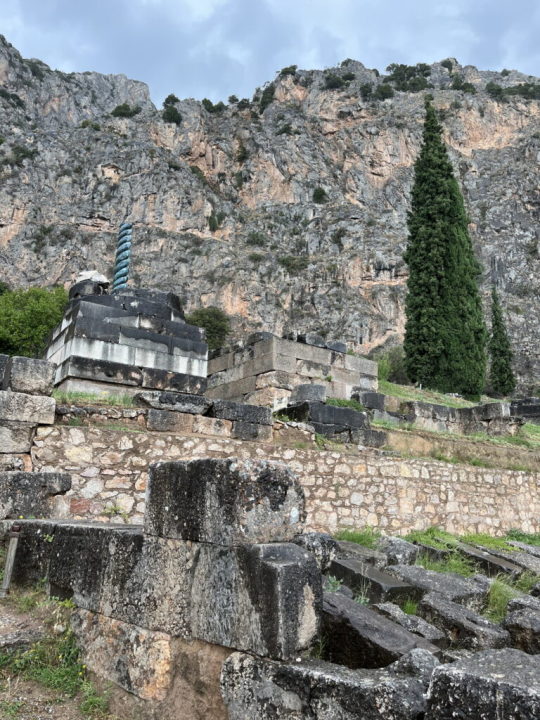

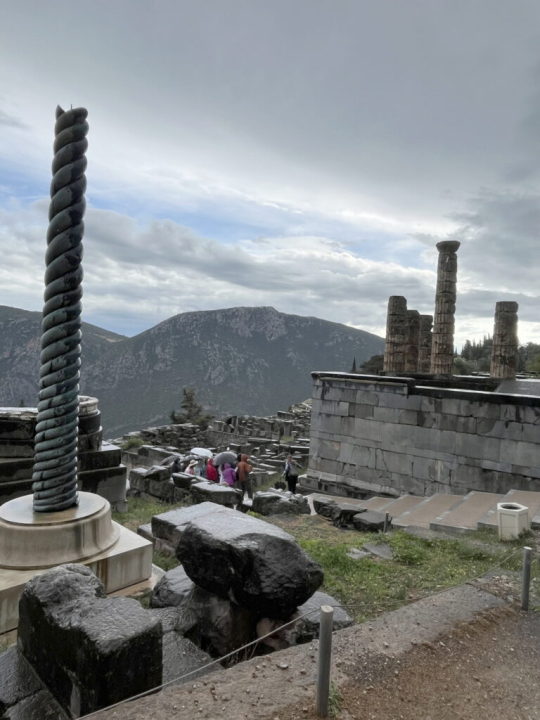
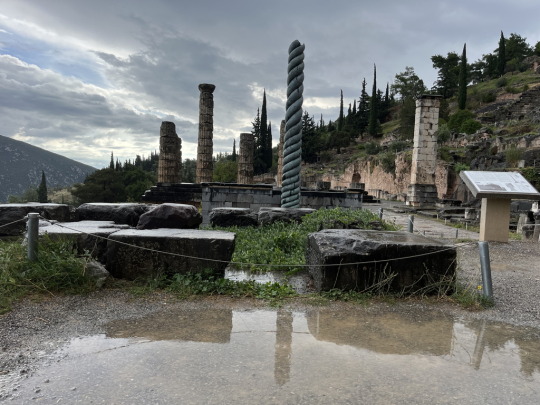

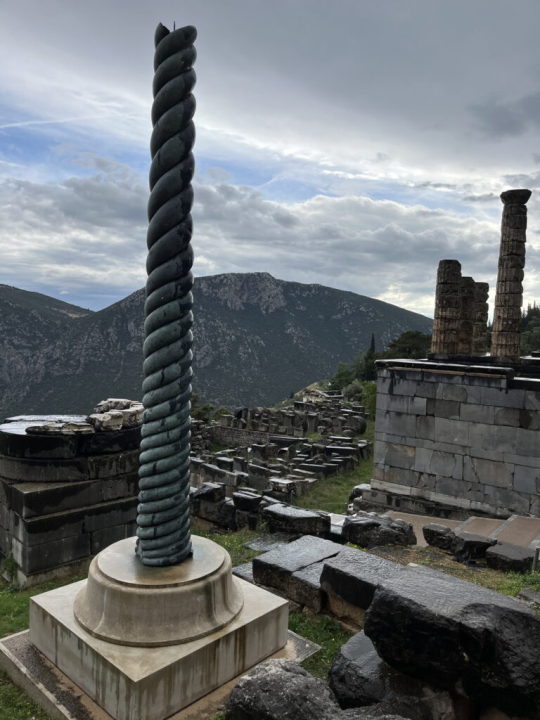


Langsam wird es Zeit, den Berg wieder hinunter zu steigen, nicht, ohne noch das eine oder andere Detail am Wege zu entdecken.

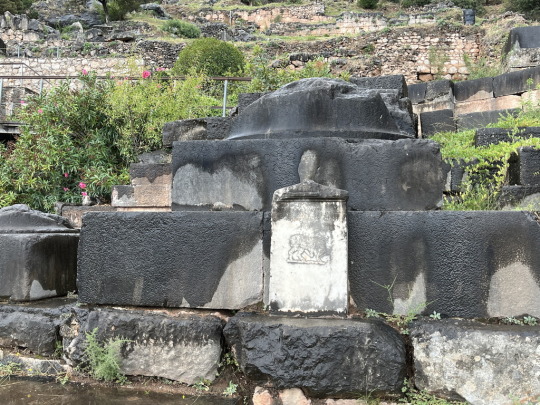
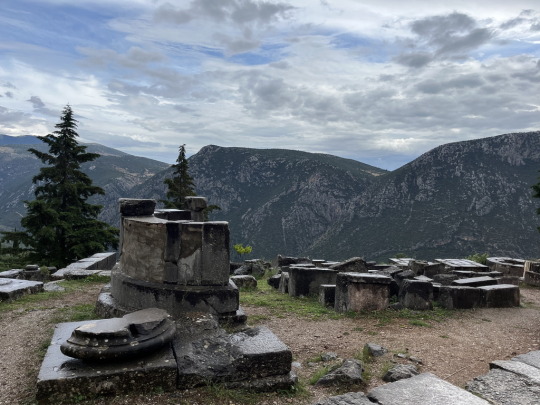

Das Museum ist modern und groß und seine Ausstellung hervorragend. Vieles kann ich den eben draußen besuchten Bauwerken zuordnen und erfahre Interessantes aus der Geschichte und wichtige Zusammenhänge.
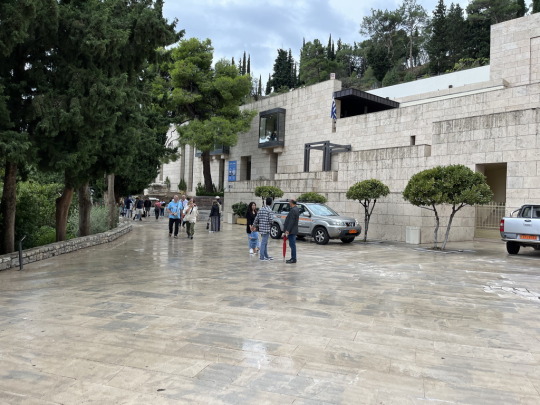
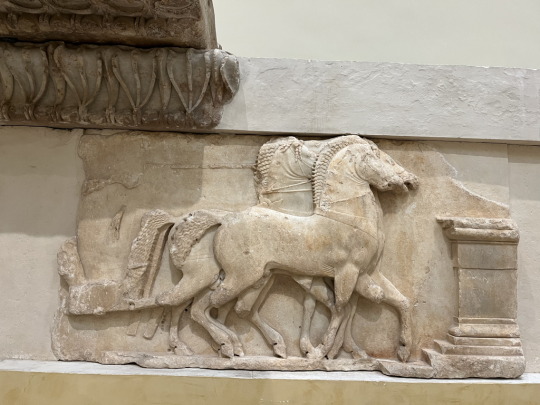





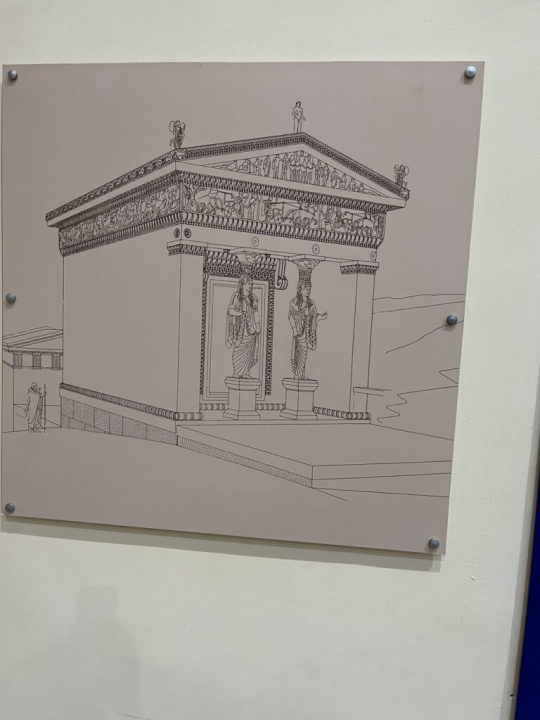


Mit einem letzten Blick ins Tal nehme ich Abschied von Delphi und habe heute definitiv einen ganz besonderen Ort besucht, dessen Zauber auch bei dem wahrlich miesen Wetter deutlich zu spüren war.
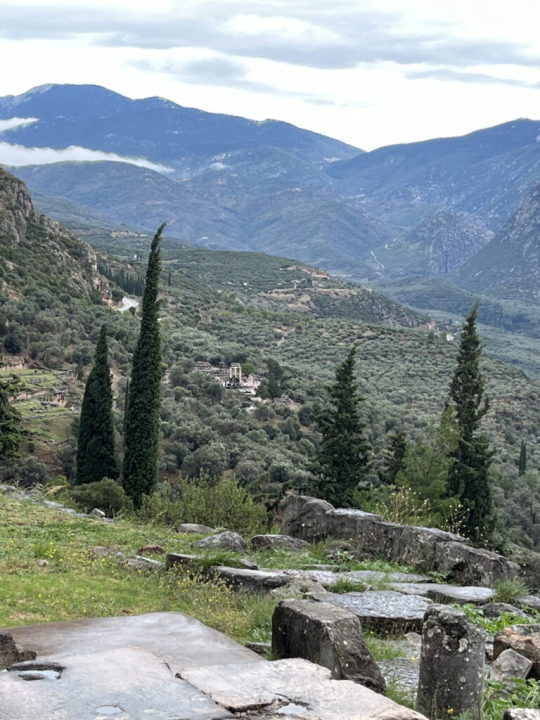
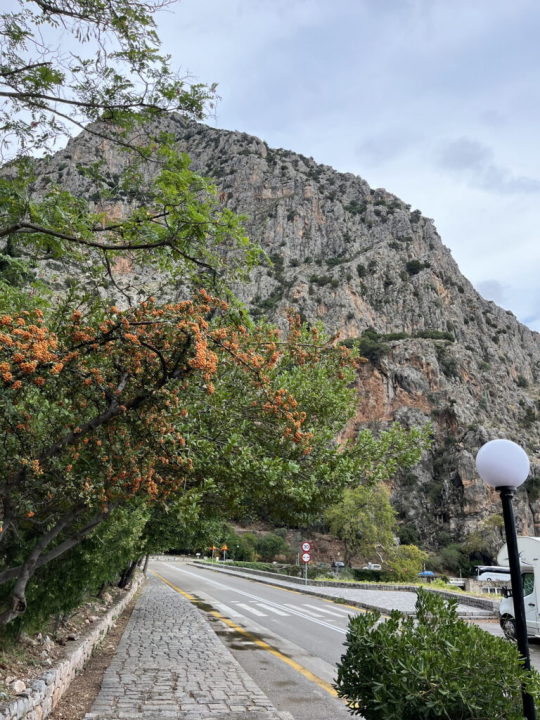

Resümee
Delphi ist ein magischer Ort, den man auf seiner Tour unbedingt einplanen sollte. Auch wenn es hier nicht die spektakulärsten Tempel und Ruinen zu sehen gibt, machen seine Lage am Ende des Tales und die gesamte Stimmung den sagenhaften Reiz dieses Ortes aus. Schon die Anfahrt ist fantastisch und wer genug Zeit mitbringt, sollte unbedingt noch hinunter zur Bucht des Golfs von Korinth fahren, die man von oben bereits blau leuchten sehen kann. Der Regen hat wieder begonnen, so dass ich mich auf die Weiterfahrt zu den Meteora-Klöstern begebe und später eine Gewitternacht in den Bergen verbringe. Die gesamte Tour go-south 3.0 ist hier beschrieben. Hier gehts zu meinem Welterbe-Projekt. Der Umbau meines Dacia Dokker als Minicamper ist hier detailliert nachzulesen. Dobbys Einrichtung und Ausstattung hat sich auch in diesem Herbst und seinen Gewittern bewährt. Meine Übernachtungsplätze habe ich wieder auf park4night gesucht und unter 5Reisende bewertet. Die zusammengefassten Länderkarten gibt es hier. Read the full article
#Abenteuermobil#Abenteuerreise#Albanien#alleinunterwegs#Alleinreisen#Ausbau#Ausrüstung#Autoreise#Besichtigung#BosnienundHerzegowina#Camping#Camping-Mobil#Dacia-Dokker#Delphi#DIY#Dobby#Erfahrungsbericht#Erkundung#Europa#Hochdach-Kombi#Inspiration#Kroatien#Leichtbau#Minicamper#Montenegro#Parkplatz#Reisebericht#Reisefotografie#Reisetagebuch#Reiseziele
0 notes
Text
O Tholos de Delphi nas ruínas do Santuário de Athena Pronaia em Delphi. Fica no mesmo local do Templo de Atena Pronaia, todos localizados a menos de um quilômetro a leste das principais ruínas de Delfos. Um tholos era uma estrutura circular e abobadada frequentemente associada ao uso religioso, como é o caso aqui. Com uma visão como esta, é fácil ver porque os Antigos acreditavam que este era um solo sagrado.
por Dan's Roman History

0 notes
Photo

The sanctuary of Athena Pronaia, Delphi (Phocis, Greece)
The sanctuary of Athena Pronaia is the first that would met the visitor as he comes via land to the Delphi. This fact gave also the name to the temple as pronaia means that it is found before the temple of Apollo in the main sanctuary.
#delphi#greece#ancient ruins#ruins#architecture#travel#europe#ancient greece#greek temple#ancient temple#ancient architecture#nature#landscape#phocis#mainland greece#archaeology#original photography#classics#classical architecture#tholos#columns
598 notes
·
View notes
